Supply Strategies and Business Model Options for Online Retailers of Agricultural Products
Abstract
1. Introduction
2. Literature Review
2.1. Agricultural Product Online Retail
2.1.1. Community Group Buying
2.1.2. Prepositioned Warehouse
2.1.3. Community Group Buying Combined with Prepositioned Warehouses
2.2. Commodity Purchase Quantity
2.3. Demand Uncertainty
2.4. Comments
- (1)
- (2)
- Many articles have studied purchase quantity or stocking decisions through the newsboy model. However, very few articles have studied the issue of purchase quantity or supply decisions for the online retailing of agricultural products in the context of agricultural e-commerce.
- (3)
- There has been no strict classification of different models for agricultural e-commerce. Existing studies in agricultural e-commerce have focused on the perishable nature of agricultural products and have considered the impact of delivery time on consumers. However, there has been no classification of agricultural e-commerce based on differences in delivery times, leading to confusion in this field of research. For example, studies on the site selection problem of community group buying do not highlight the characteristics of next-day delivery for community group buying products, and changing the research object to prepositioned warehouses does not affect the research results.
- (4)
- Scholars have conducted preliminary research on business models such as community group buying and prepositioned warehouses, but currently, the research is more independent, and no consideration has been given to which model is more suitable for the enterprise.
3. Model Building
3.1. Model Assumptions and Notation
- (1)
- p2 ≥ p1;
- (2)
- e2 ≥ e1;
- (3)
- The sale price of goods in any business model is much greater than that of any form of cost in that business model;
- (4)
- Consumers, when confronted with goods from both the prepositioned warehouse business and the community group buying business, will prefer goods from the prepositioned warehouse.
3.2. Profit Function
- (1)
- Profit function of the community group buying business
- (2)
- Profit function of prepositioned warehouse
- (3)
- Profit function of the mixed model of community group buying and prepositioned warehouse
3.3. Online Retail Supply Strategy Model for Agricultural Products
- (1)
- Community group buying
st. r ≥ 0
- (2)
- Prepositioned warehouse
st. s ≥ 0
- (3)
- Mixed model of community group buying and prepositioned warehouse
st. s ≥ 0
4. Model Solution
4.1. Supply Strategy Model Solution for Community Group Buying
st. r ≥ 0
- (1)
- λr = 0. According to the expression of the KKT condition, it can be seen that −r < 0, i.e., to carry out community group buying business the optimal value of r is found to be
- (2)
- r = 0. At this point, the KKT condition has no solution and is discarded.
4.2. Supply Strategy Model Solution for a Prepositioned Warehouse
st. s ≥ 0
- (1)
- λs = 0. According to the expression of the KKT condition, it can be seen that −s < 0, i.e., to carry out a prepositioned warehouse business the optimal value of s is found to be
- (2)
- s = 0. At this point, the KKT condition has no solution and is discarded.
4.3. Supply Strategy Model Solution for the Mixed Model
st. s ≥ 0
- (1)
- λr = 0 and λs = 0.
- (2)
- r = 0 and λs = 0.
- (3)
- λr = 0 and s = 0.
- (4)
- r = s = 0. At this point, the KKT condition has no solution and is discarded.
5. Numerical Experiments
5.1. Results
5.2. Sensitivity Analysis
- (1)
- Community group buying construction and operating cost e1
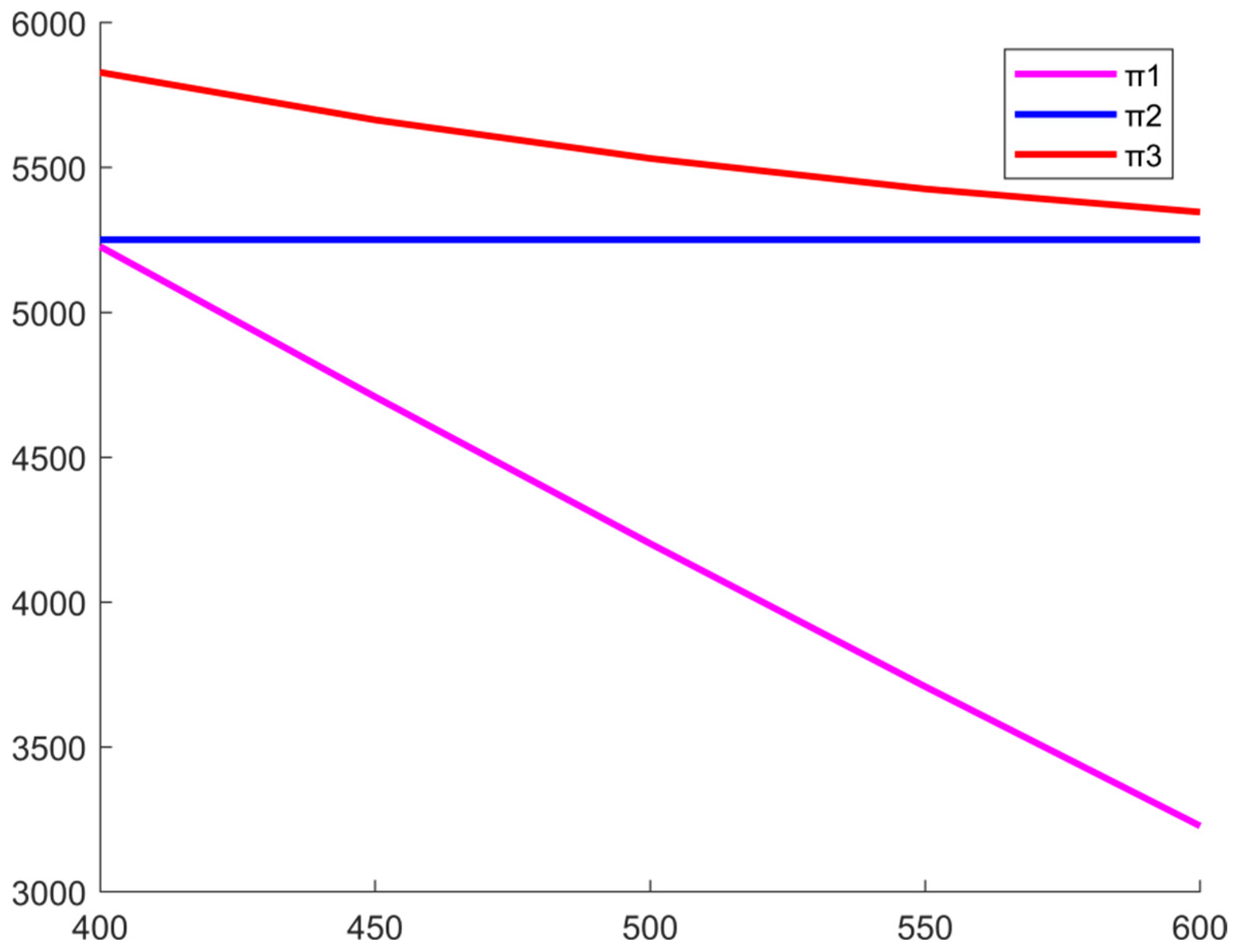
- (2)
- Prepositioned warehouse construction and operating cost e2
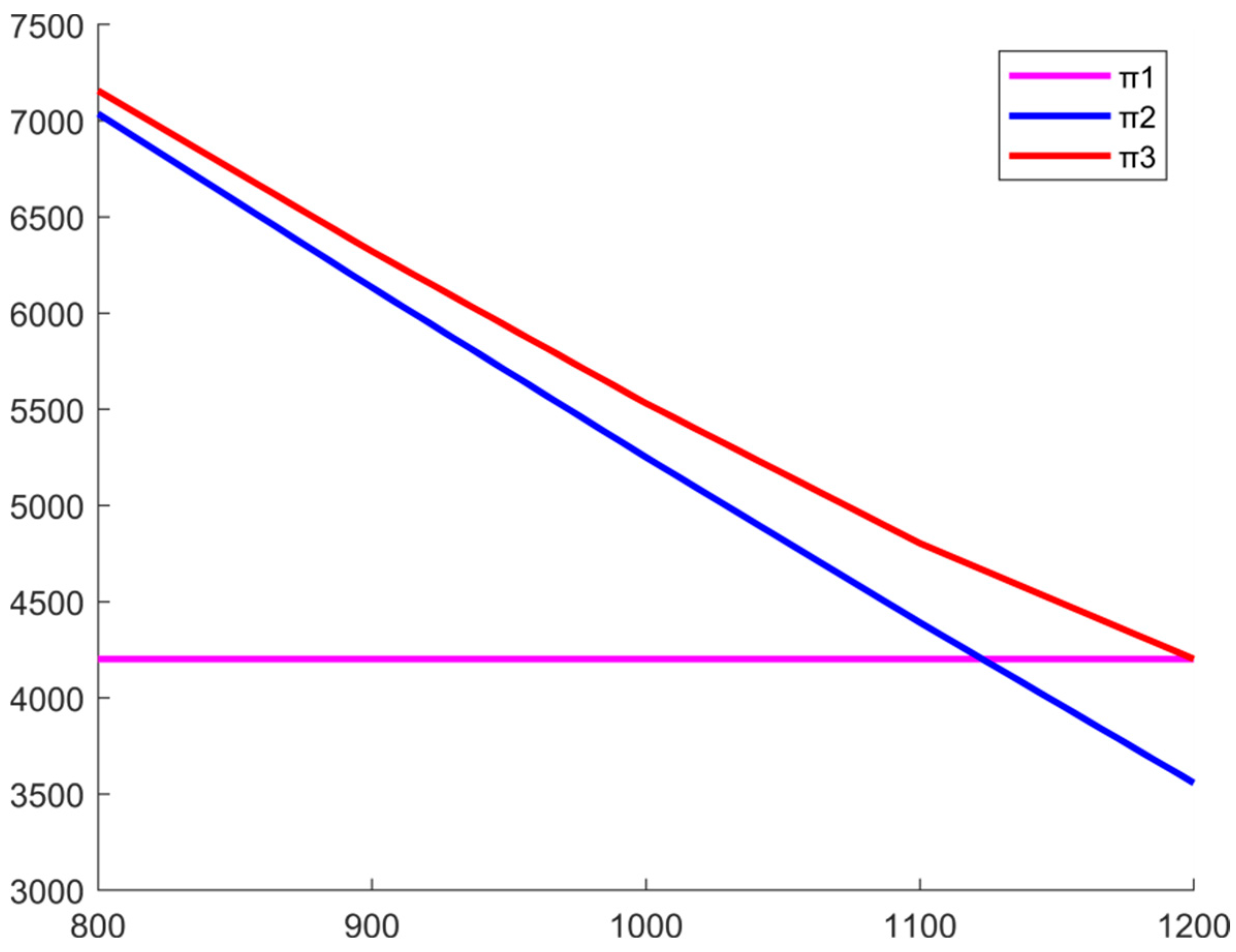
- (3)
- Procurement cost of commodities c
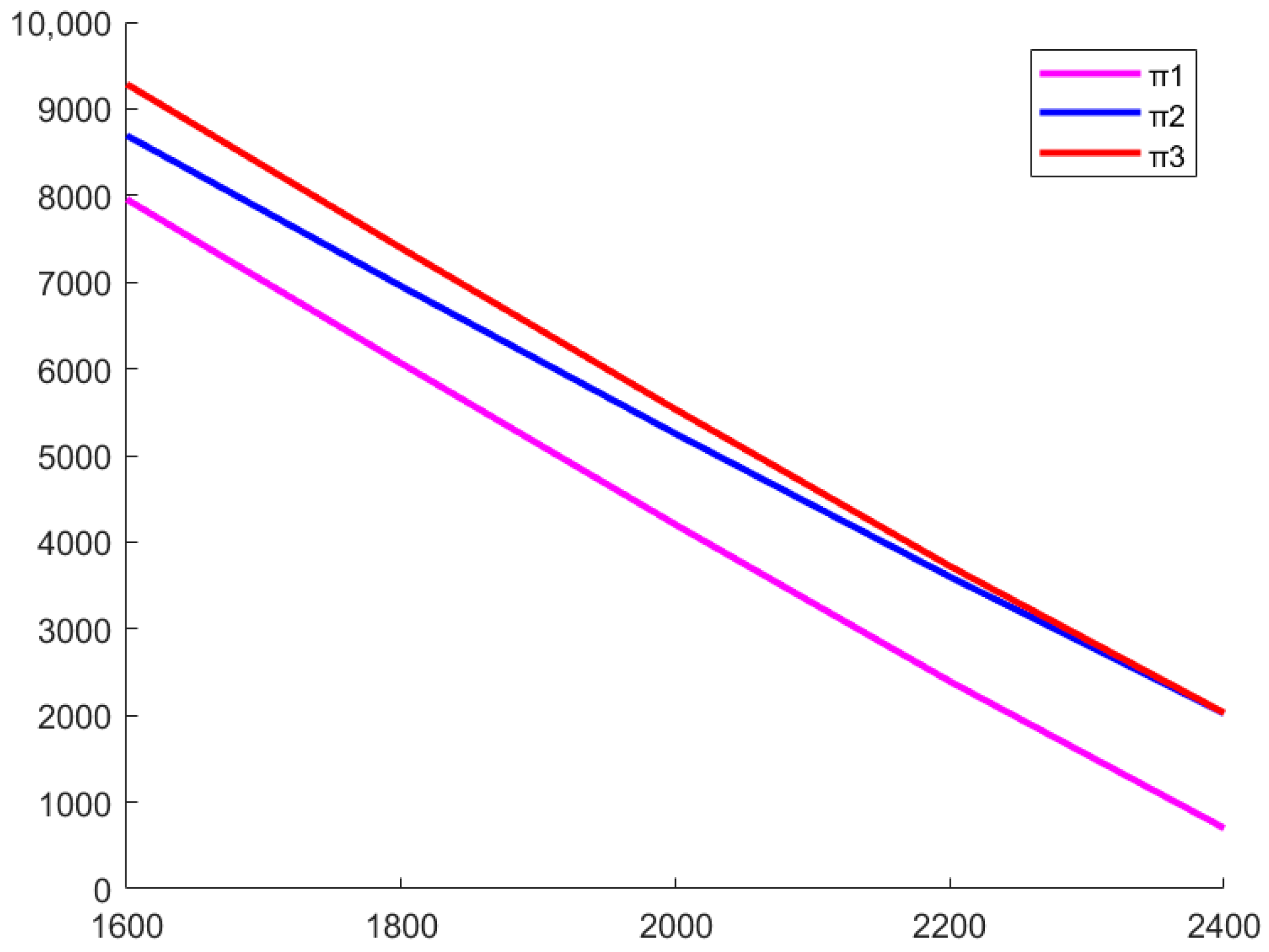
- (4)
- Holding cost of goods in prepositioned warehouse h
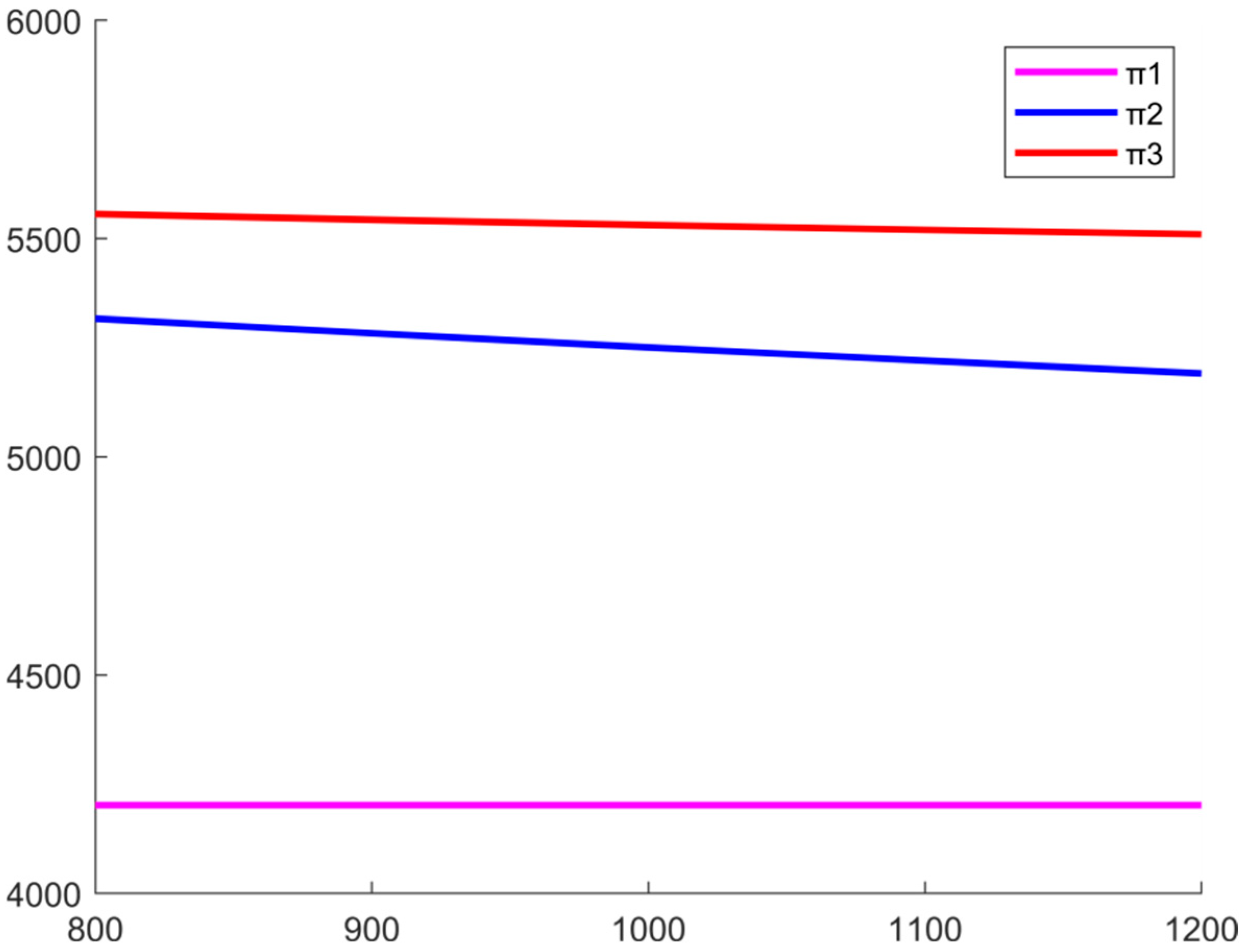
6. Discussion and Conclusions
6.1. Discussion
6.2. Research Limitation and Outlook
- (1)
- In this paper, for simplicity, it is assumed in the model that the demand for commodities is a random variable obeying a certain kind of normal distribution. In future research, the number of commodity types can increase, and different parameters and distribution functions can be used.
- (2)
- In this paper, three business models were selected according to the actual situation in China. In future research, other online retailing models for agricultural products can be discussed and added to the model.
6.3. Conclusions
- (1)
- In economically underdeveloped regions, it is appropriate for enterprises to conduct a community group buying business; in economically developed regions, it is appropriate for enterprises to conduct a prepositioned warehouse business; and in regions with average economic development, it is appropriate for enterprises to conduct both businesses.
- (2)
- The enterprise needs to determine the interval of the profit-optimal business model through each cost parameter and then formulate the business and supply strategy to be carried out according to the commodity price situation in the market.
- (3)
- To increase profits, enterprises need to focus on controlling the average procurement costs of commodities and pay attention to the construction and operating costs of the proposed business.
Author Contributions
Funding
Institutional Review Board Statement
Informed Consent Statement
Data Availability Statement
Acknowledgments
Conflicts of Interest
References
- Guo, H.; Ren, X. Effective Measures for Enhancing the Distribution Efficiency of Fresh Agricultural Products through O2O Community Group Buying. South China Agric. 2021, 15, 107–108. [Google Scholar] [CrossRef]
- Li, Z.; Wang, J. Analysis of Supply Chain Management for Dingdong Maicai under the Front Warehouse Model. Logist. Eng. Manag. 2022, 44, 55–57. [Google Scholar]
- Mao, Z.J. Discussion on Development Strategies for E-commerce Models of Fresh Agricultural Products in Front Warehouse. J. Commer. Econ. 2022, 18, 94–97. [Google Scholar]
- Liu, Q. Collaborative Optimization of Pricing and Vehicle Routing Problem for Community Group Purchase of Fresh Agricultural Products. Master’s Thesis, Kunming University of Science and Technology, Kunming, China, 2021. [Google Scholar] [CrossRef]
- Tengwei, S.; Xiumei, L.; Finance, S. Optimization of the mode of csa by implanting farmigo. J. Syst. Eng. 2016, 9, 24–32. [Google Scholar] [CrossRef]
- McDonald, R.; Christensen, C.; Yang, R.; Hollingsworth, T. AmazonFresh: Rekindling the Online Grocery Market; Harvard Business School Case 615-013; Harvard Business School Publishing: Cambdrige, MA, USA, 2014; Available online: https://www.hbs.edu/faculty/Pages/item.aspx?num=47694 (accessed on 9 July 2014).
- Galtier, F.; David-Benz, H.; Subervie, J.; Egg, J. Agricultural market information systems in developing countries: New models, new impacts. Cah. Agric. 2014, 23, 232–244. [Google Scholar] [CrossRef]
- Kauffman, R.; Wang, B. New buyers’ arrival under dynamic pricing market microstructure: The case of group-buying discounts on the internet. J. Manag. Inf. Syst. 2001, 18, 157–188. [Google Scholar] [CrossRef]
- Anand, K.; Aron, R. Group-buying on the web: A comparison of price discovery mechanisms. Manag. Sci. 2003, 49, 1546–1562. [Google Scholar] [CrossRef]
- Xue, X. Research on the construction of community-based online group buying platform. Electron. Commer. 2011, 9, 19–20. [Google Scholar] [CrossRef]
- Huang, X. Research and analysis of community group buying model based on mobile platform. Mod. Mark. 2019, 1, 101. [Google Scholar] [CrossRef]
- Yan, J. Some thoughts on the development of new retail model of community group buying. Mall Mod. 2019, 8, 17–18. [Google Scholar] [CrossRef]
- Zhu, X. Research on Fresh Produce Distribution under Community Group Purchasing Model. Master’s Thesis, Jiangnan University, Wuxi, China, 2021. [Google Scholar] [CrossRef]
- Cao, Y. Research on Optimization of Fresh Food Logistics Network Considering Direct Supply from Producing Area in the Context of Community Group Purchase. Master’s Thesis, Beijing Jiaotong University, Beijing, China, 2020. [Google Scholar] [CrossRef]
- Liu, S. Optimization Research on Front-loading Warehouse Logistics and Distribution Network of Fresh E-commerce Enterprises Based on Bi-Level Planning. Master’s Thesis, China University of Mining and Technology, Xuzhou, China, 2022. [Google Scholar] [CrossRef]
- Xie, N. Study on Competitive Site Selection of D Fresh Food e-Commerce Front-Loading Warehouse Considering Sub-Categories. Master’s Thesis, Beijing Jiaotong University, Beijing, China, 2021. [Google Scholar] [CrossRef]
- Horikawa, M.; Takeno, T.; Sugawara, M. Vendor-managed inventory for fresh agricultural products. J. Jpn. Ind. Manag. Assoc. 2016, 66, 355–362. [Google Scholar] [CrossRef]
- Chen, Y. Research on Optimization of Fresh E-Commerce Enterprises’ Front-End Warehouse Siting and Inventory Jointly under End-End Fulfillment Model. Master’s Thesis, Beijing Jiaotong University, Beijing, China, 2020. [Google Scholar] [CrossRef]
- Feng, B.; Cao, L.; Wang, S. Research on supply management of front-loading warehouse based on storage theory. Manuf. Autom. 2021, 43, 127–130. [Google Scholar]
- Huang, J. Locationand Routing Optimization of Omni-channel Mode Based Pre-positioning Warehouse. Ph.D. Thesis, Beijing Jiaotong University, Beijing, China, 2021. [Google Scholar] [CrossRef]
- Balcik, B.; Beamon, B. Facility location in humanitarian relief. Int. J. Logist. Res. Appl. 2008, 11, 101–121. [Google Scholar] [CrossRef]
- Adida, E.; Delaurentis, P.; Lawley, M. Hospital stockpiling for disaster planning. IIE Trans. 2011, 5, 43. [Google Scholar] [CrossRef]
- Burcu, B.; Deniz, A. Supplier selection for framework agreements in humanitarian relief. Prod. Oper. Manag. 2013, 23, 1028–1041. [Google Scholar] [CrossRef]
- Chang, M.; Tseng, Y.; Chen, J. A scenario planning approach for the flood emergency logistics preparation problem under uncertainty. Transp. Res. Part E 2007, 43, 737–754. [Google Scholar] [CrossRef]
- Mohammadi, R.; Ghomi, S.; Jolai, F. Prepositioning emergency earthquake response supplies: A new multi-objective particle swarm optimization algorithm. Appl. Math. Modell. 2016, 40, 5183–5199. [Google Scholar] [CrossRef]
- Das, R.; Hanaoka, S. Relief inventory modelling with stochastic lead-time and demand. Eur. J. Oper. Res. 2014, 235, 616–623. [Google Scholar] [CrossRef]
- Chakravarty; Amiya, K. Humanitarian relief chain: Rapid response under uncertainty. Int. J. Prod. Econ. 2014, 151, 146–157. [Google Scholar] [CrossRef]
- Campbell, A.; Jones, P. Prepositioning supplies in preparation for disasters. Eur. J. Oper. Res. 2011, 209, 156–165. [Google Scholar] [CrossRef]
- Chen, J.; Liang, L.; Yao, D. Pre-positioning of relief inventories for non-profit organizations: A newsvendor approach. Ann. Oper. Res. 2017, 259, 35–63. [Google Scholar] [CrossRef]
- Reimann, M. Speculative production and anticipative reservation of reactive capacity by a multi-product newsvendor. Eur. J. Oper. Res. 2011, 211, 35–46. [Google Scholar] [CrossRef]
- Reimann, M. Accurate response by postponement. Eur. J. Oper. Res. 2012, 220, 619–628. [Google Scholar] [CrossRef]
- Bicer, I.; Seifert, R. Optimal dynamic order scheduling under capacity constraints given demand-forecast evolution. Prod. Oper. Manag. 2017, 26, 2266–2286. [Google Scholar] [CrossRef]
- Garvey, M.; Carnovale, S. The rippled newsvendor: A new inventory framework for modeling supply chain risk severity in the presence of risk propagation. Int. J. Prod. Econ. 2020, 228, 107752. [Google Scholar] [CrossRef]
- Florian, L.; Chopra, S.; Seifert, R. Mitigating product shortage due to disruptions in multi-stage supply chains. Prod. Oper. Manag. 2020, 30, 941–964. [Google Scholar] [CrossRef]
- Chen, J.; Liang, L.; Yao, D. Pre-positioning of relief inventories: A multi-product newsvendor approach. Int. J. Prod. Res. 2018, 56, 6294–6313. [Google Scholar] [CrossRef]
- Zhang, W. Research on Decision Making for Mixed Reserve of Emergency Materials. Ph.D. Thesis, Beijing Jiaotong University, Beijing, China, 2023. [Google Scholar] [CrossRef]
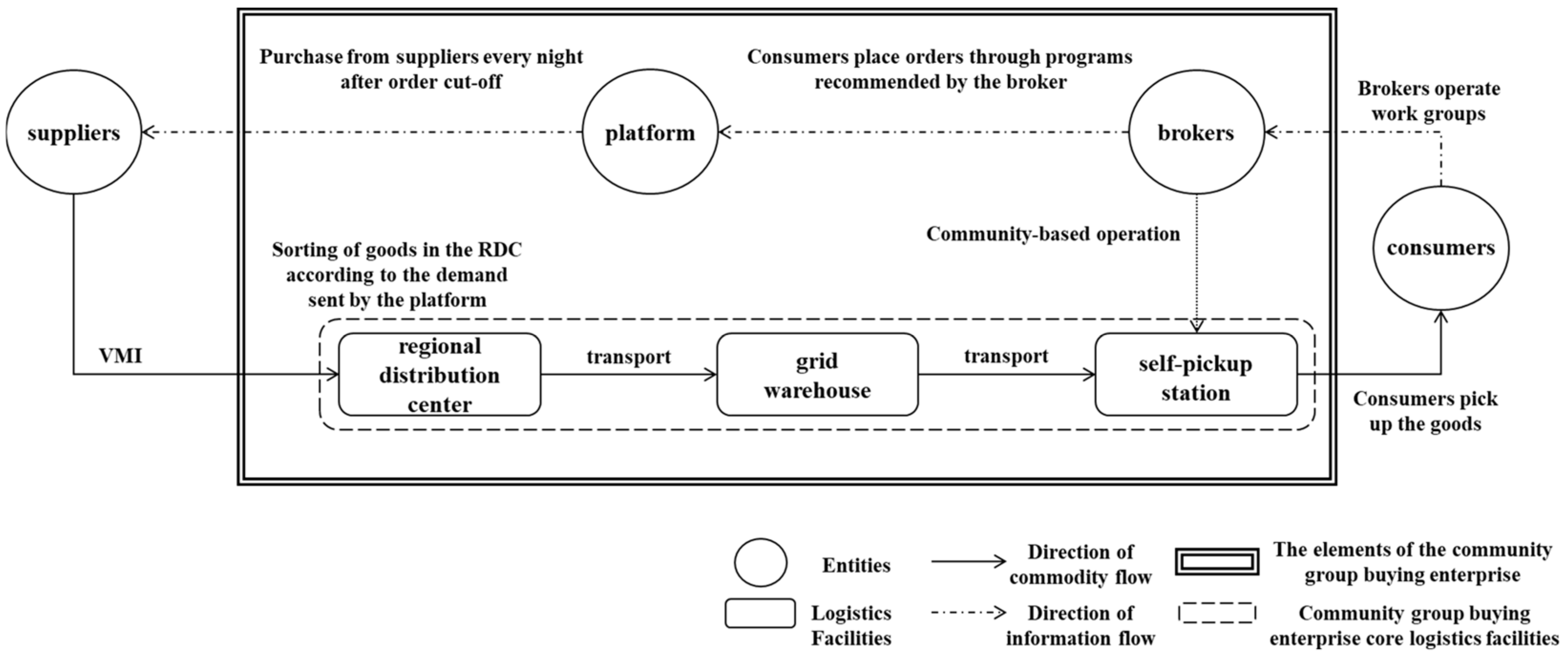


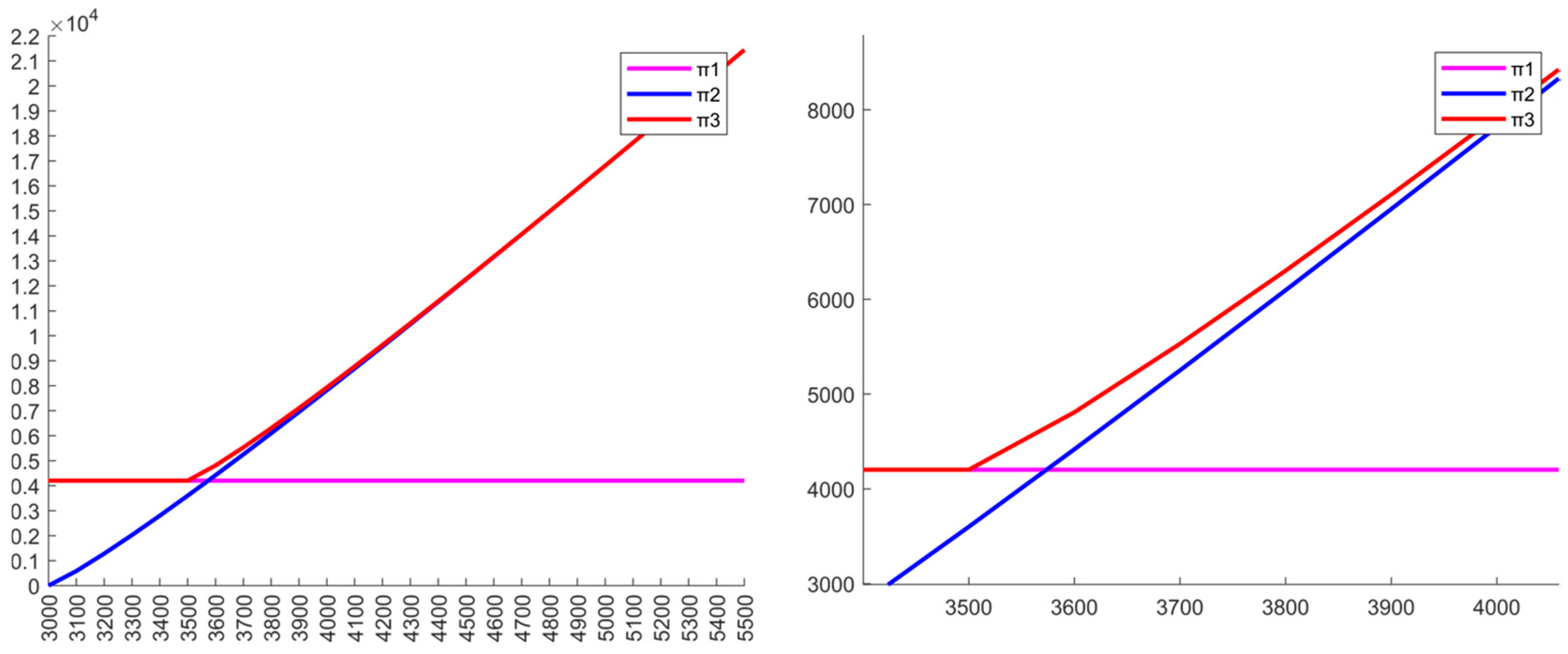
| Decision Variables | Definition |
|---|---|
| r | Commodity supply capacity of community group buying business |
| s | Commodity supply capacity of prepositioned warehouse business |
| Parameter | Definition |
|---|---|
| e1 | Community group buying construction and operation cost |
| e2 | Prepositioned warehouse construction and operation cost |
| c | Average procurement cost of commodities |
| p1 | Average sale price of goods in community group buying business |
| h | Average holding cost of goods in prepositioned warehouse |
| p2 | Average sale price of goods in prepositioned warehouse business |
| x | Stochastic demand from consumers |
| f(x) | Probability density function of demand |
| F(x) | Probability distribution function of demand |
| Parameters | Value |
|---|---|
| Community group buying construction and operation cost e1 | 500 |
| Prepositioned warehouse construction and operation cost e2 | 1000 |
| Average procurement cost of commodities c | 2000 |
| Average sale price of goods in community group buying business p1 | 3000 |
| Average holding cost of goods in prepositioned warehouse h | 1000 |
| Average sale price of goods in prepositioned warehouse business p2 | 3700 |
| Model | Optimal Supply Strategy | Profit |
|---|---|---|
| Community group buying (r1) | (10) | 4202 |
| Prepositioned warehouse (s2) | (8.7087) | 5251 |
| Mixed model (r3, s3) | (2.3737, 7.6263) | 5531 |
Disclaimer/Publisher’s Note: The statements, opinions and data contained in all publications are solely those of the individual author(s) and contributor(s) and not of MDPI and/or the editor(s). MDPI and/or the editor(s) disclaim responsibility for any injury to people or property resulting from any ideas, methods, instructions or products referred to in the content. |
© 2024 by the authors. Licensee MDPI, Basel, Switzerland. This article is an open access article distributed under the terms and conditions of the Creative Commons Attribution (CC BY) license (https://creativecommons.org/licenses/by/4.0/).
Share and Cite
Li, C.; Shi, X. Supply Strategies and Business Model Options for Online Retailers of Agricultural Products. Sustainability 2024, 16, 8734. https://doi.org/10.3390/su16208734
Li C, Shi X. Supply Strategies and Business Model Options for Online Retailers of Agricultural Products. Sustainability. 2024; 16(20):8734. https://doi.org/10.3390/su16208734
Chicago/Turabian StyleLi, Chenxing, and Xianliang Shi. 2024. "Supply Strategies and Business Model Options for Online Retailers of Agricultural Products" Sustainability 16, no. 20: 8734. https://doi.org/10.3390/su16208734
APA StyleLi, C., & Shi, X. (2024). Supply Strategies and Business Model Options for Online Retailers of Agricultural Products. Sustainability, 16(20), 8734. https://doi.org/10.3390/su16208734






